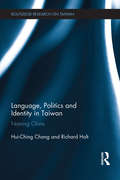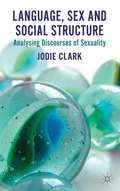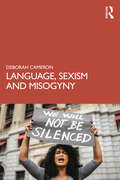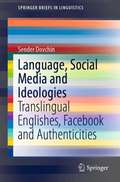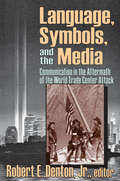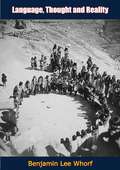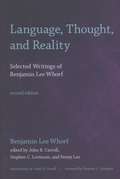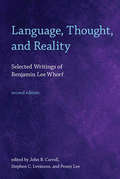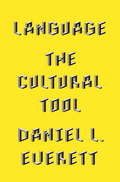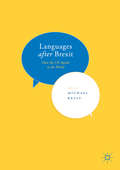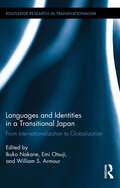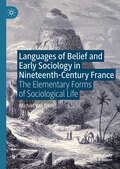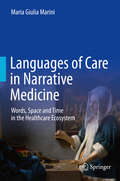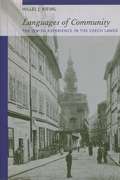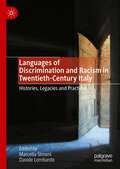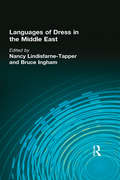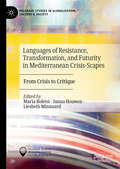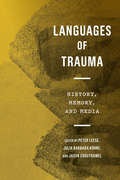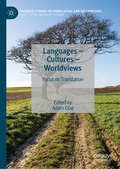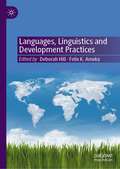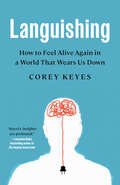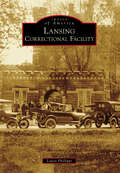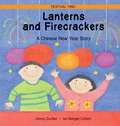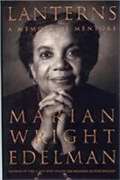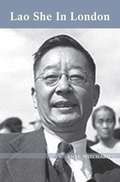- Table View
- List View
Language, Politics and Identity in Taiwan: Naming China (Routledge Research on Taiwan Series)
by Richard Holt Hui-Ching ChangFollowing the move by Chiang Kai-shek and the Chinese Nationalist Party Kuomingtang (KMT) to Taiwan after losing the Chinese civil war to the Chinese Communist Party (CCP) in the late 1940s, and Chiang’s subsequent lifelong vow to reclaim the mainland, "China " has occupied—if not monopolized—the gaze of Taiwan, where its projected images are reflected. Whether mirror image, shadow, or ideal contrast, China has been, and will continue to be, a key reference point in Taiwan's convoluted effort to find its identity. Language, Politics and Identity in Taiwan traces the intertwined paths of five sets of names Taiwan has used to name China since the KMT came to Taiwan in 1949: the derogatory "Communist bandits"; the ideologically focused "Chinese Communists"; the seemingly neutral geographical designators "mainland" and "opposite shore/both shores"; and the ethnic and national label "China," with the official designation, "People's Republic of China." In doing so, it explores how Taiwanese identities are constituted and reconstituted in the shifting and switching of names for China; in the application of these names to alternative domains of Taiwanese life; in the waning or waxing of names following tides of history and polity; and in the increasingly contested meaning of names. Through textual analyses of historical archives and other mediated texts and artifacts, the chapters chart Taiwan's identity negotiation over the past half century and critically evaluate key interconnections between language and politics. This unique book will be of great interest to students and scholars of Taiwan studies, Chinese politics, communication studies and linguistics.
Language, Sex and Social Structure
by Jodie ClarkThis book offers an innovative way of doing critical discourse analysis that focuses on the performatively produced concepts and social structures that support oppressive attitudes in a community. It draws upon ethnographic data from a women's field hockey club to examine players' homophobic attitudes towards lesbians on the team.
Language, Sexism and Misogyny
by Deborah CameronIn this vitally important and engaging text, leading feminist linguist Deborah Cameron explores the role of language and discourse in perpetuating sexism and misogyny in the twenty-first century. Covering how the linguistic expression of prejudice against women has evolved during the last fifty years, the author of the blog Language: A feminist guide pays attention both to the persistence of familiar problems, such as the dominance of men in many interactional settings, and to the emergence of new challenges such as the global rise of misogynist extremism online. The book provides students and general readers with an up-to-date survey of ideas, debates and research on a wide range of key topics, including sexist attitudes to women’s speech, verbal sexual harassment in public spaces offline and online, biases in vocabulary and grammar, the discourse of the online "manosphere" and the way violence against women is reported by the news media. Moreover, the author outlines the efforts activists have made to change sexist and misogynist language, asking what has been achieved so far, and how a new generation is addressing current concerns. Accessible, non-technical and informed by scholarship from a wide range of disciplines from linguistics and anthropology to history, media studies and sociology, this text is essential reading for courses on language and gender in English language, linguistics, women’s and gender studies, media and communication studies.
Language, Social Media and Ideologies: Translingual Englishes, Facebook and Authenticities (SpringerBriefs in Linguistics)
by Sender DovchinThis book seeks to contribute to the critical applied linguistics by investigating the dynamic role of English on social media, focusing on EFL university students in East Asia – Mongolia and Japan. Drawing on sets of Facebook data, the book primarily emphasizes that the presence of English on social media should be understood as ‘translingual’ not only due to its multiple recombinations of resources, genres, modes, styles, and repertories but also due to its direct connections with a broader socio-cultural, historical and ideological meanings. Secondly, EFL university students metalinguistically claim multiple ideologies of linguistic authenticities in terms of their usage of ‘translingual Englishes’ on social media as opposed to other colliding language ideologies such as linguistic purity and linguistic dystopia. The question of how they reclaim the notion of linguistic authenticity, however, profoundly differs, depending on their own often-diverse criteria, identities, beliefs, and ideas. This shows that mixing and mingling at its very core, the existence of ‘translingual Englishes’ on social media provides us with a significant view to accommodate the multiple co-existence and multiple origins of authenticity in the increasingly interconnected world. The book concludes the possibility of applying the ideas of ‘translingual Englishes’ on social media in critical EFL classroom settings, in their careful re-assessment of the complexity of contemporary linguistic experiences and beliefs of their EFL learners.
Language, Symbols, and the Media: Communication in the Aftermath of the World Trade Center Attack
by Robert E., DentonThe terrorist attacks of September 11, 2001 created a new political landscape and a new era of warfare. Language, Symbols, and the Media, now in paperback, offers insights into the impact and influence of 9/11 upon our cultural, social, and political life. The book opens with an introductory chapter on communications, media language, and visual symbolism in the immediate wake of the attacks. The second chapter considers the challenge to religious pluralism, analyzing the grounds for the immediate backlash against Islam. Chapter 3 reviews several crucial historical and contemporary Supreme Court rulings relevant to the limitations of free speech in times of war and national crises. The consideration of First Amendment rights is continued in chapter 4, which places the Patriot Act in historical context by comparing the legislation and its interpretation of it to other legislation passed in response to past American crises. The immediate aftermath of the attacks witnessed many calls for an end to "the age of irony" and a return to "traditional values." Chapter 5 considers some contrarian responses and analyzes the impact of irony as a rhetorical device in American culture. The unifying role of sport in the post-9/11 healing process in America is examined in chapter 6. Chapter 7 examines the reactions and responses of young adults to the events of 9/11 one year later. Chapter 8 demonstrates how politicians received a public "makeover" of their careers. Chapter 9 explores the impact of 9/11 on the rhetoric of advertising, while chapter 10 focuses more closely on how it affected the tourism industry. A concluding chapter examines several instances of media self-censorship and its implications for the policymaking process during times of crisis. This volume will be of interest to cultural studies specialists, sociologists, journalists, political scientists, historians, as well as general readers.
Language, Thought and Reality: Selected Writings (The\mit Press Ser.)
by Benjamin Lee WhorfWritings by the pioneering linguist Benjamin Whorf, including his famous work on the Hopi language as well as general reflections on language and meaning. The pioneering linguist Benjamin Whorf (1897–1941) grasped the relationship between human language and human thinking: how language can shape our innermost thoughts. His basic thesis is that our perception of the world and our ways of thinking about it are deeply influenced by the structure of the languages we speak. The writings collected in this volume include important papers on the Maya, Hopi, and Shawnee languages as well as more general reflections on language and meaning.—Print ed.
Language, Thought, and Reality
by Stephen C. Levinson Penny Lee Benjamin Lee Whorf John B. CarrollThe pioneering linguist Benjamin Whorf (1897--1941) grasped the relationship between human language and human thinking: how language can shape our innermost thoughts. His basic thesis is that our perception of the world and our ways of thinking about it are deeply influenced by the structure of the languages we speak. The writings collected in this volume include important papers on the Maya, Hopi, and Shawnee languages, as well as more general reflections on language and meaning. Whorf's ideas about the relation of language and thought have always appealed to a wide audience, but their reception in expert circles has alternated between dismissal and applause. Recently the language sciences have headed in directions that give Whorf's thinking a renewed relevance. Hence this new edition of Whorf's classic work is especially timely.The second edition includes all the writings from the first edition as well as John Carroll's original introduction, a new foreword by Stephen Levinson of the Max Planck Institute for Psycholinguistics that puts Whorf's work in historical and contemporary context, and new indexes. In addition, this edition offers Whorf's "Yale Report," an important work from Whorf's mature oeuvre.
Language, Thought, and Reality, second edition: Selected Writings of Benjamin Lee Whorf
by Benjamin Lee WhorfWritings by a pioneering linguist, including his famous work on the Hopi language, general reflections on language and meaning, and the "Yale Report."The pioneering linguist Benjamin Whorf (1897–1941) grasped the relationship between human language and human thinking: how language can shape our innermost thoughts. His basic thesis is that our perception of the world and our ways of thinking about it are deeply influenced by the structure of the languages we speak. The writings collected in this volume include important papers on the Maya, Hopi, and Shawnee languages, as well as more general reflections on language and meaning.Whorf's ideas about the relation of language and thought have always appealed to a wide audience, but their reception in expert circles has alternated between dismissal and applause. Recently the language sciences have headed in directions that give Whorf's thinking a renewed relevance. Hence this new edition of Whorf's classic work is especially timely.The second edition includes all the writings from the first edition as well as John Carroll's original introduction, a new foreword by Stephen Levinson of the Max Planck Institute for Psycholinguistics that puts Whorf's work in historical and contemporary context, and new indexes. In addition, this edition offers Whorf's "Yale Report," an important work from Whorf's mature oeuvre.
Language: The Cultural Tool
by Daniel L. EverettA bold and provocative study that presents language not as an innate component of the brain--as most linguists do--but as an essential tool unique to each culture worldwide. For years, the prevailing opinion among academics has been that language is embedded in our genes, existing as an innate and instinctual part of us. But linguist Daniel Everett argues that, like other tools, language was invented by humans and can be reinvented or lost. He shows how the evolution of different language forms--that is, different grammar--reflects how language is influenced by human societies and experiences, and how it expresses their great variety. For example, the Amazonian Pirahã put words together in ways that violate our long-held under-standing of how language works, and Pirahã grammar expresses complex ideas very differently than English grammar does. Drawing on the Wari' language of Brazil, Everett explains that speakers of all languages, in constructing their stories, omit things that all members of the culture understand. In addition, Everett discusses how some cultures can get by without words for numbers or counting, without verbs for "to say" or "to give," illustrating how the very nature of what's important in a language is culturally determined. Combining anthropology, primatology, computer science, philosophy, linguistics, psychology, and his own pioneering--and adventurous--research with the Amazonian Pirahã, and using insights from many different languages and cultures, Everett gives us an unprecedented elucidation of this society-defined nature of language. In doing so, he also gives us a new understanding of how we think and who we are.
Languages after Brexit
by Michael KellyThis book represents a significant intervention into the debates surrounding Brexit and language policy. It analyses the language capabilities and resources of the United Kingdom in a new, post-referendum climate, in which public hostility towards foreign languages is matched by the necessity of renegotiating and building relationships with the rest of Europe and beyond. The authors scrutinize the availability of key resources in diverse sectors of society including politics, economics, business, science and education, while simultaneously offering practical advice and guidance on how to thrive in the new international environment. This extremely timely edited collection brings together leading researchers from across the field of language policy, and is sure to appeal not only to students and scholars of this subject, but also to practitioners, policy makers and educators.
Languages and Identities in a Transitional Japan: From Internationalization to Globalization (Routledge Research in Transnationalism)
by Ikuko Nakane Emi Otsuji William S. ArmourThis book explores the transition from the era of internationalization into the era of globalization of Japan by focusing on language and identity as its central themes. By taking an interdisciplinary approach covering education, cultural studies, linguistics and policy-making, the chapters in this book raise certain questions of what constitutes contemporary Japanese culture, Japanese identity and multilingualism and what they mean to local people, including those who do not reside in Japan but are engaged with Japan in some way within the global community. Topics include the role of technology in the spread of Japanese language and culture, hybrid language use in an urban context, the Japanese language as a lingua franca in China, and the identity construction of heritage Japanese language speakers in Australia. The authors do not limit themselves to examining only the Japanese language or the Japanese national/cultural identity, but also explore multilingual practices and multiple/fluid identities in "a transitional Japan." Overall, the book responds to the basic need for better accounts of language and identity of Japan, particularly in the context of increased migration and mobility.
Languages of Belief and Early Sociology in Nineteenth-Century France: The Elementary Forms of Sociological Life
by Michiel Van DamThis book presents a new reading of the history of French social science and religion through an investigation of early sociology’s techniques for narrating the category of belief. The author argues that by looking at the history of social sciences in this manner, we gain a deeper understanding of both our present debates on post-secularity as well as our modernist past, both of which were thoroughly shaped by their reflections and critiques on the notion of belief yet failed to enter into any sort of meaningful communication with each other. This book seeks to rectify this failure by introducing the concept of ‘belief-languages’, an anthropological framework designed to historicize different discussions on belief and allow for their comparative description and analysis.
Languages of Care in Narrative Medicine: Words, Space and Time in the Healthcare Ecosystem
by Maria Giulia MariniThis book explains how narrative medicine can improve evidence based medicine (EBM), making it more effective and efficient, giving patients better quality of life and offering more satisfaction to all health care providers. It discusses not only the disease experienced by the person who is ill, but also focuses on the context and the culture, and investigates how narrative medicine can make other disciplines around the globe more applicable, less manipulative, and more “scientific”. Only by integrating the narrative aspects, can EBM become more effective and efficient, with fewer uncured patients, more satisfied patients with a better quality of life, and satisfaction for all health care providers. Every chapter is divided into two main sections: the first presents the latest research in the field, with comments and interviews with experts, while the second section provides a list of practical exercises and tasks. The book is intended for anyone with an interest in caring for and curing patients: all care providers of care, physicians, general practitioners, specialists nurses, psychotherapists, counselors, social workers, providers of aid, healthcare managers, scientific societies, academics and researchers.
Languages of Community: The Jewish Experience in the Czech Lands
by Hillel J. KievalIn the Czech lands, Kieval writes, Jews have felt the need constantly to define and articulate the nature of group identity, cultural loyalty, memory, and social cohesiveness, and the period of "modernizing" absolutism, which began in 1780, brought changes of enormous significance.
Languages of Discrimination and Racism in Twentieth-Century Italy: Histories, Legacies and Practices
by Davide Lombardo Marcella SimoniThis volume represents one of the first extensive studies that investigates the persistence of questions of race and racism in Italy from the liberal age to the present, through colonialism, Fascism and post-war Italy. It adopts an interdisciplinary perspective to investigate the intertwining of the cultural, social, legislative and political dynamics of discrimination in Italy’s past and present. Drawing upon the expertise of historians, political scientists, sociologists, scholars of literature and experts in cultural studies, the original essays collected in this volume show a remarkable continuity and the persistence of racism in the Italian cultural and political discourse, in society and in the representation of Others. They also speak of the shifting of practices of Othering from one group to another in different historical contexts.
Languages of Dress in the Middle East
by Bruce Ingham Nancy Lindisfarne-TapperConsiders how the languages of dress in the region connect with other social practices, and with political and religious conformity in particular. Treating cases as diverse as practices of veiling in Oman and dress reform laws in Turkey, these ethnographic studies extend from Malta to the ME and Caucasus.
Languages of Resistance, Transformation, and Futurity in Mediterranean Crisis-Scapes: From Crisis to Critique (Palgrave Studies in Globalization, Culture and Society)
by Maria Boletsi Janna Houwen Liesbeth MinnaardThis collection rethinks crisis in relation to critique through the prism of various declared ‘crises’ in the Mediterranean: the refugee crisis, the Eurozone crisis, the Greek debt crisis, the Arab Spring, the Palestinian question, and others. With contributions from cultural, literary, film, and migration studies and sociology, this book shifts attention from Europe to the Mediterranean as a site not only of intersecting crises, but a breeding ground for new cultures of critique, visions of futurity, and radical imaginaries shaped through or against frameworks of crisis. If crisis rhetoric today serves populist, xenophobic or anti-democratic agendas, can the concept crisis still do the work of critique or partake in transformative languages by scholars, artists, and activists? Or should we forge different vocabularies to understand present realities? This collection explores alternative mobilizations of crisis and forms of art, cinema, literature, and cultural practices across the Mediterranean that disengage from dominant crisis narratives. Chapter 1 is available open access under a Creative Commons Attribution 4.0 International License via link.springer.com.
Languages of Trauma: History, Memory, and Media (G - Reference,information And Interdisciplinary Subjects Ser.)
by Peter Leese Jason Crouthamel Julia Barbara KöhneThis volume traces the distinct cultural languages in which individual and collective forms of trauma are expressed in diverse variations, including oral and written narratives, literature, comic strips, photography, theatre, and cinematic images. The central argument is that traumatic memories are frequently beyond the sphere of medical, legal, or state intervention. To address these different, often intertwined modes of language, the contributors provide a variety of disciplinary approaches to foster innovative debates and provoke new insights. Prevailing definitions of trauma can best be understood according to the cultural and historical conditions within which they exist. Languages of Trauma explores what this means in practice by scrutinizing varied historical moments from the First World War onwards and particular cultural contexts from across Europe, the United States, Asia, and Africa – striving to help decolonize the traditional Western-centred history of trauma, dissolving it into multifaceted transnational histories of trauma cultures.
Languages – Cultures – Worldviews: Focus on Translation (Palgrave Studies in Translating and Interpreting)
by Adam GłazThis edited book explores languages and cultures (or linguacultures) from a translation perspective, resting on the assumption that they find expression as linguacultural worldviews. Specifically, it investigates how these worldviews emerge, how they are constructed, shaped and modified in and through translation, understood both as a process and a product. The book’s content progresses from general to specific: from the notions of worldview and translation, through a consideration of how worldviews are shaped in and through language, to a discussion of worldviews in translation, both in macro-scale and in specific details of language structure and use. The contributors to the volume are linguists, linguistic anthropologists, practising translators, and/or translation studies scholars, and the book will be of interest to scholars and students in any of these fields.
Languages, Linguistics and Development Practices
by Deborah Hill Felix K. AmekaThis edited book presents case-studies and reflections on the role of languages and their analytic study in development practices across four regions: Africa, Asia, Australia, and the Pacific. The authors highlight the importance of conceptual studies of languages and cultures, as well as language choice, for enhancing development practices, demonstrating the value that language analysis and the humanities can add to the already multi-disciplinary field of Development Studies. The chapters draw on the fields of linguistics, human geography, education, diverse economies, community learning, sociology, and anthropology, and topics covered include some significant areas of interest to sustainable human development: education, work, finances, age, gender; as well as a key approach to development (asset-based community development). Chapters on informal adult learning provide opportunities to explore how and why language and linguistic analysis is relevant to development projects. The volume aims to promote collaboration and interdisciplinary dialogue and should be of interest to academics, practitioners and students of language and development, and to those working in the field of development globally.
Languishing: How to Feel Alive Again in a World That Wears Us Down
by Corey Keyes&“With his pioneering research, Corey Keyes put languishing on the map. In this powerful book, he brings it to life. Get ready to rethink your understanding of mental health, update your views on happiness, and come closer to realizing your potential.&”—Adam Grant, #1 New York Times bestselling author of Hidden PotentialIf you&’re muddling through the day in a fog, often forgetting why you walked into a room . . . If you feel emotionally flattened, lacking the energy to socialize or feel joy in the small things . . . If you feel an inner void—like something is missing, but you aren&’t sure what . . . Then this book is for you.Languishing—the state of mental weariness that erodes our self-esteem, motivation, and sense of meaning—can be easy to brush off as the new normal, especially since indifference is one of its symptoms. It is not a synonym for depression and its attendant state of prolonged sadness. Languishers are more likely to feel out of control of their lives, uncertain about what they want from the future, and paralyzed when faced with decisions. Left unchecked, languishing not only impedes our daily functioning but is a gateway to serious mental illness and early mortality.Emory University sociologist Corey Keyes has spent his career studying the causes and costs of languishing—the neglected middle child of mental health. Now Keyes has written the first definitive book on the subject, examining the ripple effect of languishing on our lives before deftly diagnosing the larger forces behind its rise: the false promises of the self-help industrial complex, a global moment of intense fear and loss, and a failing healthcare system focused on treating rather than preventing illness.Ultimately, Keyes presents a counterintuitive approach to breaking the cycles keeping us stuck and finding a path to true flourishing. Unlike self-improvement systems offering quick-fix mood boosts, his framework focuses on functioning well: taking simple but powerful steps to hold our emotions loosely, becoming more accepting of ourselves and others, and carving out daily moments for the activities that create cycles of meaning, connection, and personal growth.Languishing is a must-read for anyone tempted to downplay feelings of demotivation and emptiness as they struggle to haul themselves through the day, and for those eager to build a higher tolerance for adversity and the pressures of modern life. We can expand our vocabulary for describing our inner experiences and deepest needs—and, with it, our potential to flourish.
Lansing Correctional Facility
by Laura PhillippiSince 1868, the Lansing Correctional Facility (formerly the Kansas State Penitentiary) has stood watch over what would become the city of Lansing. Designed by Erasmus Carr, architect of the Kansas State Capitol, the prison is the oldest in Kansas. In the beginning, it housed male and female inmates from Kansas and Oklahoma, as well as inmates serving federal sentences. Today, the facility's population of minimum, medium, maximum, and special management custody offenders is approximately 2,400. Leavenworth County has also seen the addition of the United States Disciplinary Barracks, United States Penitentiary-Leavenworth, and Corrections Corporation of America-Leavenworth, making it the only county in the country to host a state, military, federal, and private prison. Images of America: Lansing Correctional Facility features photographs of the early days, when inmates were on the "silent system" and could not speak to one another, to more modern times when rehabilitation has become an important component of prison life.
Lanterns and Firecrackers: A Chinese New Year Story
by Jonny ZuckerA Chinese family prepares for their New Year festivities they decorate the house with flowers, then set off firecrackers to scare away bad spirits and welcome the coming year. Family and friends sit down together for a festive dinner, then go outside to watch the parade of dragon dancers. The festival ends on its final night with a display of colored lanterns. Festival Time books depict the activities of typical families, as Mom, Dad, and children celebrate holidays that have special religious or cultural significance for them. Cheerfully attractive color illustrations supplement a simply-told story of the holiday's origins and a description of the festivities that are part of that holiday. Festival Time books can be read aloud to toddlers, but are easy enough for many first and second graders to read to themselves. Each book's final two-page spread is written mainly for parents, offering suggestions for ways to communicate the holiday's meaning to kids. (Ages 3-7) Picture descriptions present.
Lanterns: A Memoir of Mentors
by Marian Wright EdelmanMemoir by founder of the Children's Defense Fund with portraits of the many mentors who helped shape her.
Lao She in London
by Anne WitchardLao She remains revered as one of China's great modern writers. His life and work have been the subject of volumes of critique, analysis and study. However, the four years the young aspiring writer spent in London between 1924 and 1929 have largely been overlooked. Dr Anne Witchard, a specialist in the modernist milieu of London between the wars, reveals Lao She's encounter with British high modernism and literature from Dickens to Conrad to Joyce. Lao She arrived from his native Peking to the whirl of London's West End scene - Bloomsburyites, Vorticists, 'avant-gardists' of every stripe, Ezra Pound and the cabaret at the Cave of The Golden Calf. Immersed in the West End 1920s world of risque flappers, the tabloid sensation of England's 'most infamous Chinaman Brilliant Chang' and Anna May Wong's scandalous film 'Piccadilly', simultaneously Lao She spent time in the notorious and much sensationalised East End Chinatown of Limehouse. Out of his experiences came his great novel of London Chinese life and tribulations - 'Mr Ma and Son: Two Chinese in London' ('Er Ma', 1929). However, as Witchard reveals, Lao She's London years affected his writing and ultimately the course of Chinese modernism in far more profound ways.
